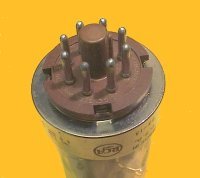
6D5
|
|
||||||||||||||||||||||||||||||||||||
|
Hits: 1321 Replies: 0
THE "ORIGINAL NINE" METAL TUBES AND THE FORGOTTEN 6D5
|
|
|
Jacob Roschy
31.Jan.23 |
1
By Ludwell Sibley OTB vol. 32 Feb 92, No 4 The history of the all-metal receiving tube is detailed in Bro. Patrick Dowd's landmark article, "History and Development of the All-Metal Radio Tube," in the OTB. It appeared in Vol. 16 No. 4 (Mar. 1976) and Vol. 17 No. 1 (June 1976). The initial line of these "tin tubes" from RCA, as actually used commercially, contained nine items: the 5Z4 rectifier in a perforated "birdcage" case, five+ inches high; the 6A8 pentagrid converter; the 6C5 triode, in its stepped two-diameter package; the 6F5 top-cap triode; the 6F6 power pentode; the 6H6 duo-diode, in a short flat-topped can; the 6J7 and 6K7 pentodes; and the 6L7 pentagrid mixer. As made before about mid-1936, these had logotypes and other identification steel-stamped into the shells, rather than the familiar ink-stamping. This makes them interesting collectibles - "get the set" - as well as truly correct parts for restoring vintage radios from 1935-36. But the composition of the "original nine" depends on what source one uses. The list of electrical characteristics given in the July 1935 issue of QST gives all the above units except the 6F5. Instead, it lists the 6D5 power triode. This design had the basic size of the 6F6, carried similar heater and dissipation ratings, but was basically a repackaged 45. When Sylvania announced its second-source metal line (Sylvania News, Vol. 5 No. 11, undated but apparently ca. July 1935), its offering included all ten types. Now, mid-1935 was not a good time to bring out small power triodes. Pentode output tubes were clearly the wave of the future. If one really wanted an audio triode, it was no problem to triode-connect a 6F6. RCA quickly shuffled its line and dropped the 6D5. It vanished so completely that RCA tube literature doesn't mention the 6D5, even as a "discontinued" item. (See, for example, the 1937 RC-13 tube manual. The 1936 ARRL Handbook and 1937 Sylvania Technical Manual also ignore it.) Sylvania wasted no time pruning its line in 1935, either; Vol. 5 No. 12 of the Sylvania News announced the final 6F6-sized version of the 5Z4 and mentioned "nine types now in use"; Vol. 6 No. 2 refers to the 6D5 as "originally announced but withdrawn." A scan of about 7000 tube lineups in 1935-36 radios in the 1938 Mallory-Yaxley Radio Servicing Encyclopedia shows not one 6D5. The 6F6, by contrast, was quite popular. But RCA did make a few of these, the sample in the photo has the original steel-stamped RCA - RADIOTRON - MADE-IN U. S. A. - CUNNINGHAM markings. It is shaped like a 6F6 except that the top is slightly dished-in rather than being domed. A pair of 6D5s appears as a modulated oscillator in a "Metal-Tube 5-Meter Transmitter-Receiver" in the 1937 Frank C. Jones Radio Handbook (p. 342). Someone (probably not RCA) registered a 6D5G with the Radio Manufacturers Association in June 1935, someone (surely not RCA, maybe Arcturus) registered a metal-glass 6D5MG in July. (To add mystery, the EIA-JEDEC type-number listing of January 1967 indicates that a 6D5 was registered in May, 1941.) The steel-stamped tubes were used in the first octal-tube radios. Quite often an Atwater Kent 317, a GE A-75, etc. turns up with some of the original tubes in place. Almost invariably the 5Z4 and 6H6 have been replaced, suggesting poor reliability in the early production. (Birdcage 5Z4s with full emission are rare indeed.) It is most appropriate to refit these sets with all stamped types. A dud birdcage 5Z4 can always be fixed up by putting some silicon diodes and a dropping resistor inside; there's ample room. It is possible to make a rather good simulation of a 5Z4 from a perforated-case octal ballast tube and the same diode-resistor combination. Incidentally, with the original tube a child could stick a thin nail or hairpin through the perforations and contact the 300 volts or so on the bare anodes. In short: nobody has a problem replacing 6D5s but collecting a full set of "nine" of radio sets original tubes really calls for ten items!
The "original nine" (ten). (Markings whitened for legibility)
|
End of forum contributions about this tube
| Data Compliance | More Information |





